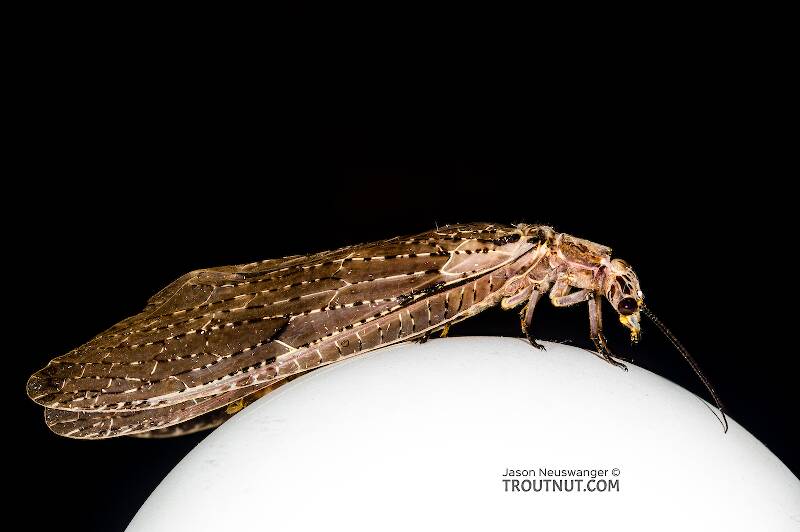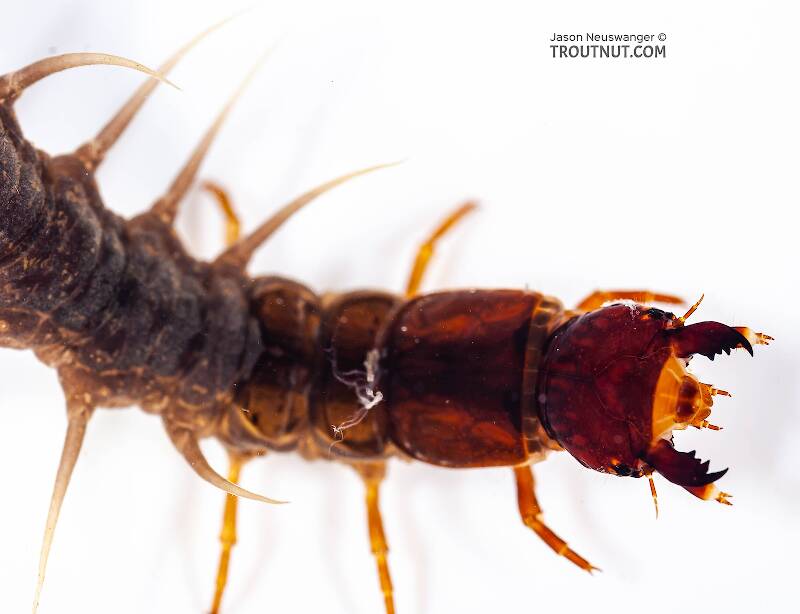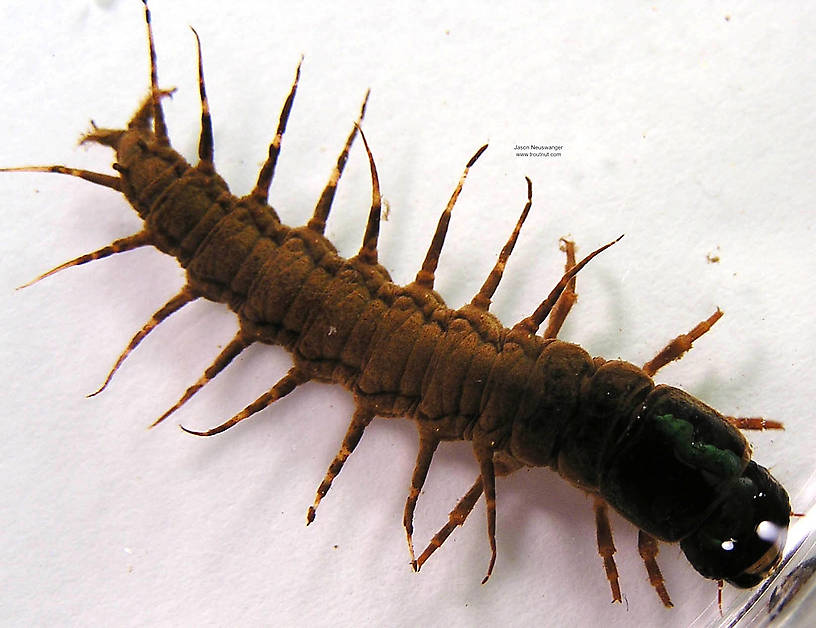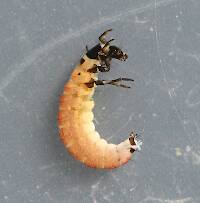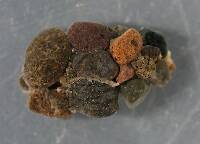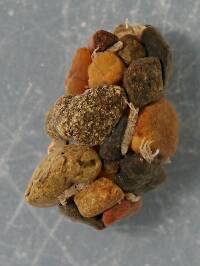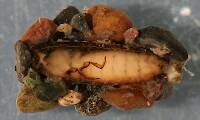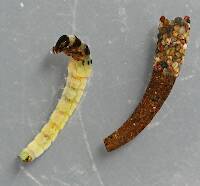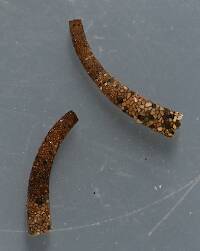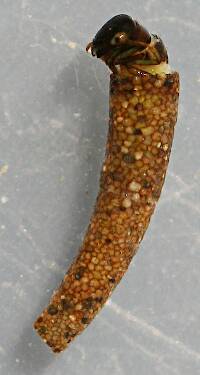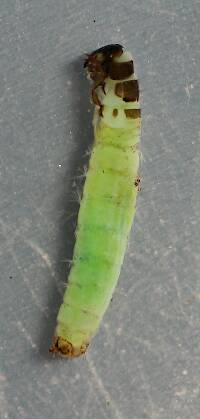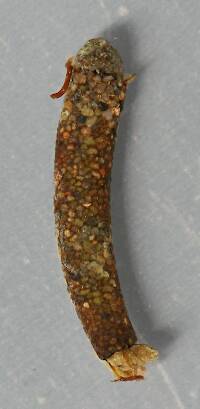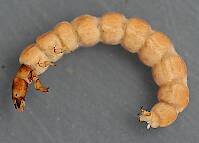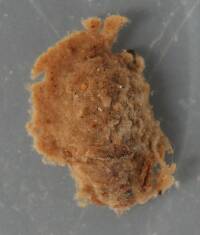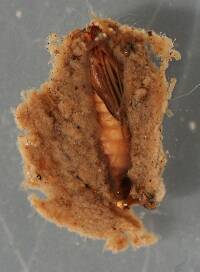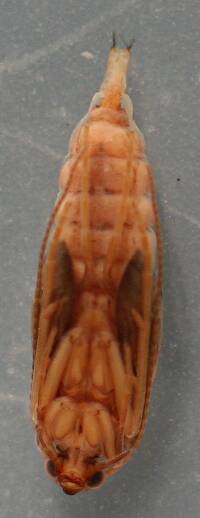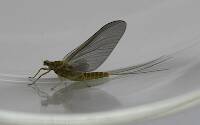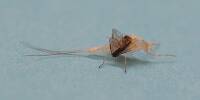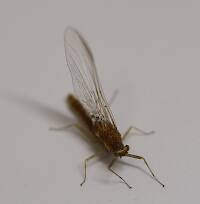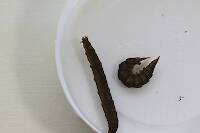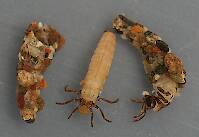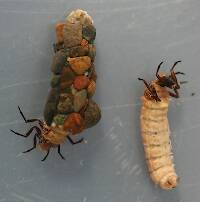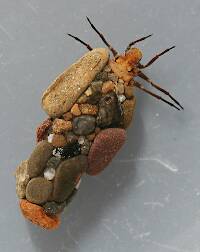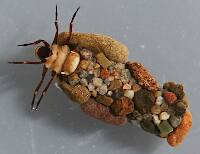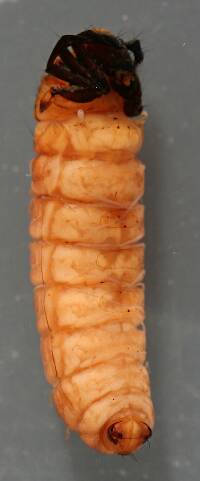
Salmonflies
Pteronarcys californica
The giant Salmonflies of the Western mountains are legendary for their proclivity to elicit consistent dry-fly action and ferocious strikes.
Featured on the forum

This dun emerged from a mature nymph on my desk. Unfortunately its wings didn't perfectly dry out.

Troutnut is a project started in 2003 by salmonid ecologist Jason "Troutnut" Neuswanger to help anglers and
fly tyers unabashedly embrace the entomological side of the sport. Learn more about Troutnut or
support the project for an enhanced experience here.
This topic is about the Insect Family Corydalidae
Hellgrammites are the vicious larvae of the Dobsonflies, some of the only trout stream insects which pose a biting threat to the angler. The pincers of the adult are even more frightening that the larva's, and they're aggressive enough to use them once in a while.This family's life cycle does not create good dry fly opportunities, but the larvae may be eaten by trout year-round. They are a secret told only by stomach samples of well-fed trout.
Example specimens
Troutnut on Nov 18, 2006November 18th, 2006, 7:19 am EST
I'm working on a magazine article about hellgrammites, which I think are a generally underrated food source and an extremely cool group of insects.
I'm going to do a lot of research and combine it with my own experiences, but many of you have been fly fishing longer than I've been alive, so I'd like to see if any of you have stories about them -- catching big trout with stomachs full of them, finding trout rising to the dobsonfly adults, getting bit by these bugs, or anything else.
I'm going to do a lot of research and combine it with my own experiences, but many of you have been fly fishing longer than I've been alive, so I'd like to see if any of you have stories about them -- catching big trout with stomachs full of them, finding trout rising to the dobsonfly adults, getting bit by these bugs, or anything else.
Jason Neuswanger, Ph.D.
Troutnut and salmonid ecologist
Troutnut and salmonid ecologist
Shawnny3 on Nov 18, 2006November 18th, 2006, 11:30 am EST
I doubt it's helpful, but the first time I caught a hellgrammite nymph I put it in a jar with a whole bunch of other mayfly and stonefly nymphs and took them home to my tying bench. The flies I tied weren't very memorable, but it was pretty cool to watch the hellgrammite systematically bite every other nymph in half. Scary little buggers.
-Shawn
-Shawn
Jewelry-Quality Artistic Salmon Flies, by Shawn Davis
www.davisflydesigns.com
www.davisflydesigns.com
Litobrancha on Dec 5, 2006December 5th, 2006, 4:36 am EST
Jason I was working on my M.S. on the Horsepasture River in NC and we had to camp in the backcountry near Lake Jocassee. There is an iron bridge there that stays warm after dark and it's a good place to lay and watch flying squirrels soar across the river, backlit by the sky. When I got up to go back to camp I turned my headlight on (we'd seen a lot of copperheads out at night here). Instantly I was mobbed by big Corydalus adults, probably twenty or so. Had to walk back in the dark.
Other places nearby (Toxaway River) there were vertical rock faces over the stream that had literally thousands of egg masses (fifty cent piece sized white splotches) over the water. Would have loved to observe the oviposition frenzy that must have been.
cheers
Other places nearby (Toxaway River) there were vertical rock faces over the stream that had literally thousands of egg masses (fifty cent piece sized white splotches) over the water. Would have loved to observe the oviposition frenzy that must have been.
cheers
GONZO on Dec 6, 2006December 6th, 2006, 6:44 am EST
Jason, I wish I had more to offer on this topic, but my experiences with imitating and fishing hellgrammites have been underwhelming. I've devised a number of imitations over the years. I've tried several curved imitations (the larvae tend to curl defensively like a salmonfly nymph when drifting), but I was unhappy with the size of the hook required and the large gaff-like gap that resulted. The most promising imitation was a realistic articulated pattern that allowed the use of a smaller hook. Unlike most of my experiments with hinged flies, however, this one was only a mediocre fly. I managed a few decent trout and even a couple of steelhead on the pattern before abandoning it.
Even though I find dobsonfly and fishfly larvae in the majority of my seine samples, I doubt that they ever drift in significant numbers. And I've never witnessed the adults ovipositing on the water. I also doubt that the Woolly Bugger is taken for a hellgrammite even though that was the idea behind Russ Blessing's original. When trout are in a general feeding mode, specific imitation is seldom called for. The Bugger is just an extremely effective suggestion of life that succeeds well under general feeding conditions.
Beyond this, I can share two little tales that may (or may not) be of interest. As a teen, I once spent the night on a large rock in the midst of a fastwater stretch of the Susquehanna at Duncannon. It was the middle of a solitary two-day float, and sleeping on the rock seemed like a good idea at the time. Well, the rock was uncomfortable, my sleeping bag was soaked, and the constant attention of several large dobsonflies made sleep impossible. In the morning, I set off down the river cold, wet, sore, and cursing the abominable insects.
Years later, I was trying to teach some kids, who were participating in a summer camp, to fish (on the Lehigh River). Kids will be kids, and when the fishing (catching) was slow they'd pursue other forms of entertainment. My vain attempt to keep the kids on task was sharply interrupted by the shrill ear-splitting screams that only young girls seem capable of producing. I ran over expecting to see a watersnake slithering into the river. Instead, I discovered that two girls had been digging in the sand along the bank and their excavations had uncovered two large pupating hellgrammites (C. cornuta--the big uglies). I calmed the girls and explained about the alien monsters, but the thing that fascinates me to this day is the color of the larvae. They were bright yellow. This clearly indicated a recent molt, but it also seemed to suggest that hellgrammites undergo a molt while in their terrestrial stage prior to their final transformation into adults. I've never found any information that would confirm this, but I can think of no other explanation.
I'll also pass along a worthless bit of name confusion from the web. Corydalis cornuta is not only the scientific name for a species of dobsonfly but also for a species of flowering herb in the family Fumariaceae!
Even though I find dobsonfly and fishfly larvae in the majority of my seine samples, I doubt that they ever drift in significant numbers. And I've never witnessed the adults ovipositing on the water. I also doubt that the Woolly Bugger is taken for a hellgrammite even though that was the idea behind Russ Blessing's original. When trout are in a general feeding mode, specific imitation is seldom called for. The Bugger is just an extremely effective suggestion of life that succeeds well under general feeding conditions.
Beyond this, I can share two little tales that may (or may not) be of interest. As a teen, I once spent the night on a large rock in the midst of a fastwater stretch of the Susquehanna at Duncannon. It was the middle of a solitary two-day float, and sleeping on the rock seemed like a good idea at the time. Well, the rock was uncomfortable, my sleeping bag was soaked, and the constant attention of several large dobsonflies made sleep impossible. In the morning, I set off down the river cold, wet, sore, and cursing the abominable insects.
Years later, I was trying to teach some kids, who were participating in a summer camp, to fish (on the Lehigh River). Kids will be kids, and when the fishing (catching) was slow they'd pursue other forms of entertainment. My vain attempt to keep the kids on task was sharply interrupted by the shrill ear-splitting screams that only young girls seem capable of producing. I ran over expecting to see a watersnake slithering into the river. Instead, I discovered that two girls had been digging in the sand along the bank and their excavations had uncovered two large pupating hellgrammites (C. cornuta--the big uglies). I calmed the girls and explained about the alien monsters, but the thing that fascinates me to this day is the color of the larvae. They were bright yellow. This clearly indicated a recent molt, but it also seemed to suggest that hellgrammites undergo a molt while in their terrestrial stage prior to their final transformation into adults. I've never found any information that would confirm this, but I can think of no other explanation.
I'll also pass along a worthless bit of name confusion from the web. Corydalis cornuta is not only the scientific name for a species of dobsonfly but also for a species of flowering herb in the family Fumariaceae!
Troutnut on Dec 6, 2006December 6th, 2006, 7:13 am EST
I do believe hellgrammites drift enough to be significant at times. I base that on the fact that they turn up often enough in stomach contents on the rare occasion that I keep a trout. I've found 4 or 5 hellgrammites in one trout before. I don't know how often that happens, but it says to me that at least sometimes they're relevant in the drift.
Jason Neuswanger, Ph.D.
Troutnut and salmonid ecologist
Troutnut and salmonid ecologist
GONZO on Dec 6, 2006December 6th, 2006, 7:42 am EST
Jason, I agree that they can be significant, but it seems that their significance may have more to do with size rather than numbers. (After all, finding 4 or 5 caddisfly larvae in a trout's stomach is relatively insignificant, especially if it contains other prey as well.) It's an open question with me whether certain common but intermittently encountered food forms (especially large ones) provoke a specific focus or specific recognition by trout. I've had experiences that seem to argue for and against that notion. It appears to be a very individualized response.
PS--I pushed the submit button accidentally before my previous post was complete. I wonder if you have any thoughts about the yellow terrestrial larvae.
PS--I pushed the submit button accidentally before my previous post was complete. I wonder if you have any thoughts about the yellow terrestrial larvae.
Martinlf on Dec 6, 2006December 6th, 2006, 11:47 am EST
My hellgrammite experiences are limited to the smallmouth and rock bass fishing days of my youth. It was commonly believed on my home river in Tennessee that hellgrammite larvae were one of the best baits ever, and they certainly were effective when my dad and I used them. We would kick seine for them in a riffle just upstream from an old rock steel and wood one lane bridge, turning over one well known big rock and always finding a multitude of the ugly bugs. I don't remember, though, ever finding any of them in the stomachs of fish we cleaned, though I remember vividly five or six reddish hornets we found in the belly of a fat rock bass. I can imagine him finding one floating along, but how did he encounter so many at one time? It's still a mystery to me.
"He spread them a yard and a half. 'And every one that got away is this big.'"
--Fred Chappell
--Fred Chappell
GONZO on Dec 6, 2006December 6th, 2006, 4:20 pm EST
Litobrancha wrote:
Sorry to interrupt this thread's train of thought, but I just had to call attention to this strikingly beautiful image. Thank you, Lito.
PS--Has anyone else noticed the similarity between a hellgrammite and the thing that is placed in Chekov's ear in the Star Trek movie, The Wrath of Kahn? I wonder if it was the model for that alien life form?
There is an iron bridge there that stays warm after dark and it's a good place to lay and watch flying squirrels soar across the river, backlit by the sky.
Sorry to interrupt this thread's train of thought, but I just had to call attention to this strikingly beautiful image. Thank you, Lito.
PS--Has anyone else noticed the similarity between a hellgrammite and the thing that is placed in Chekov's ear in the Star Trek movie, The Wrath of Kahn? I wonder if it was the model for that alien life form?
Troutnut on Dec 6, 2006December 6th, 2006, 6:29 pm EST
I guess I'm trying to say that you have to define what you mean by important. Except perhaps in some localized areas, they don't offer much in the way of drift, though.
Yeah, I'm sure they're not a major factor in any stream by body count, biomass, or any similar measure compared to the more common orders. My definition of "important" involves being eaten by trout in decent numbers, even if it's a very localized event.
Jason Neuswanger, Ph.D.
Troutnut and salmonid ecologist
Troutnut and salmonid ecologist
Brett on Dec 7, 2006December 7th, 2006, 4:49 am EST
I'm sorta new here, but thought I'd put in some anecdotal info on hellgrammites. I work along the Potomac River near Shepherdstown, WV...in an area which seems to have plenty of Corydalus cornutus. As they are attracted to the lights outside our work area at night, I can usually come out in the mornings during the summer and find adults on the buildings...at least those that weren't eaten by bats and nighthawks. Incidentally, Bats and nighthawks seem to like all parts except the wings and head capsules. I can usually walk the parking lot, picking up wings and divide by four to see how many were eaten on a particular night there. Mid to late-June appears to be the peak of the emergence...though I find adults from early June through early July. I have found larvae over 100 yards from the river...evidently looking for that "perfect spot" to dig in and pupate. I've heard that the riffles near Bluestone Dam, south of Beckley, WV, support an incredible number of hellgrammites and that the march out of the water to pupate can cause the roads to get a bit greasy. Perhaps the coldwater release and constant temp makes for a more "synchronous" emergence time. Incidentally I understand that the "pinchers" on adult dobsonflies are relatively useless. I handle them with forceps regardless. (I think it is the male who has long scissorlike pinchers)
Brett
Novice entomologist, fly-tyer and photographer
Novice entomologist, fly-tyer and photographer
GONZO on Dec 7, 2006December 7th, 2006, 4:54 am EST
Thanks for the clarification, David. I agree that it makes no sense to have two species (one plant, one animal) with the same scientific name. I think you'll find, however, that a great many of the scientific and entomological sites have yet to catch up to this distinction. To see what I mean, you need only Google Corydalis cornuta. Numerous university and governmental sites use this name for the dobsonfly species in question. I trust that Corydalus cornutus is the accepted dobsonfly nomen, though the level of that acceptance leaves something to be desired.
PS--Brett, welcome aboard. I'm glad you've decided to participate. My understanding is also that the formidable pincers of adult males are largely for show (unlike the larval mouthparts).
PS--Brett, welcome aboard. I'm glad you've decided to participate. My understanding is also that the formidable pincers of adult males are largely for show (unlike the larval mouthparts).
Brett on Dec 7, 2006December 7th, 2006, 5:06 am EST
Checking my main bug manual, Merritt and Cummins' "An Introduction to the Aquatic Insects of North America, 3rd edition" it appears that Corydalus cornutus (which should be underlined or italicized, since it is Latin, is the accepted scientific name of the very common large megalopteran most of us know as hellgrammites or go-devils. By the way, I highly recommend the Merritt and Cummins book (now in a newer edition) if anyone seriously wants to get into bug work. It is very good in explaining the major aquatic insect orders, families and generra, but doesn't get into species. I recommend it is a basic text, with other species-specific books or papers for your area of interest.
Brett
Novice entomologist, fly-tyer and photographer
Novice entomologist, fly-tyer and photographer
Martinlf on Dec 7, 2006December 7th, 2006, 5:31 am EST
This is pure trivia, and non-hellgrammite related, but Brett's comments on the discards of bats and nighthawks reminded me of an experience on the Delaware. I was fishing with a guide and we saw several mayfly wing and thorax combos floating along with missing abdomens. At first we hypothesized that a small trout must have bitten the abdomen right off. Then we saw a dragonfly intercept a sulphur mid flight, chew up the abdomen almost instantly, and let the wings and thorax fall, helicoptering like a winged maple seed. This is probably not news to the entomologists here, but some everyday anglers might not have yet noticed this phenomenon. Gonzo, do we have a wing and thorax tie yet?
"He spread them a yard and a half. 'And every one that got away is this big.'"
--Fred Chappell
--Fred Chappell
GONZO on Dec 7, 2006December 7th, 2006, 5:44 am EST
Brett,
As a computer illiterate, I had to ask Jason how to italicize when posting. The procedure is to place {i} before the italicized material and {/i} after (except with straight brackets rather than the curly ones).
By the way, the Perlidae specimens you brought to the FFF get-together were indeed Acroneuria spp. (Probably Acroneuria lycorias, though the achohol-faded markings were a bit difficult to recognize at first.)
Louis,
I haven't found trout to be that interested in dragonfly discards, but you never know. I am reminded of an evening on Mud Run when my fishing partner's fly mysteriously ascended skyward, towing a good portion of the tip of his fly line. His fly, while having a minimal effect on the trout we were pursuing, was sufficiently convincing to a large dragonfly--a testament to the powerful flight and lifting capabilities of these insects!
As a computer illiterate, I had to ask Jason how to italicize when posting. The procedure is to place {i} before the italicized material and {/i} after (except with straight brackets rather than the curly ones).
By the way, the Perlidae specimens you brought to the FFF get-together were indeed Acroneuria spp. (Probably Acroneuria lycorias, though the achohol-faded markings were a bit difficult to recognize at first.)
Louis,
I haven't found trout to be that interested in dragonfly discards, but you never know. I am reminded of an evening on Mud Run when my fishing partner's fly mysteriously ascended skyward, towing a good portion of the tip of his fly line. His fly, while having a minimal effect on the trout we were pursuing, was sufficiently convincing to a large dragonfly--a testament to the powerful flight and lifting capabilities of these insects!
Troutnut on Dec 7, 2006December 7th, 2006, 6:14 am EST
it appears that Corydalus cornutus is the accepted scientific name of the very common large megalopteran most of us know as hellgrammites or go-devils
That's interesting. I was fairly confident in my identification of most of the Corydalid specimens I've collected as Nigronia serricornis. If Corydalus is more common, I might have to rethink that. Would any of you with more detailed entomological training like to have a look at the specimens on this site and double-check my ID?
I hadn't seen that name "go-devils" before. Can you tell me any more about its usage? I'll add it to the database.
By the way, I highly recommend the Merritt and Cummins book (now in a newer edition)
Are you talking about the 1995 version (third edition)? I've got that one, and you're right, it's great. I've heard rumors a new edition is out this year, but I haven't seen it for sale yet.
About the dragonflies: That's a really interesting observation, and something I hadn't noticed before. I'm going to spin those posts off into their own discussion in the dragonfly section.
Jason Neuswanger, Ph.D.
Troutnut and salmonid ecologist
Troutnut and salmonid ecologist
GONZO on Dec 7, 2006December 7th, 2006, 6:23 am EST
Jason,
According to Ethan Bright, "Only Nigronia serricornis is widespread in Michigan." He also says that "Corydalus cornutus is restricted to warm-water streams," though I have encountered them in larger "marginal" trout streams (like the Lehigh River). The two are pretty hard to mistake for one another.
PS--While I certainly defer to the professionals on this, I've scanned the specimens, and they all appear to be Nigronia (and probably serricornis) to me. C. cornutus appears broader (more flattened) and has distinctive whitish gill tufts at the base of the lateral filaments.
According to Ethan Bright, "Only Nigronia serricornis is widespread in Michigan." He also says that "Corydalus cornutus is restricted to warm-water streams," though I have encountered them in larger "marginal" trout streams (like the Lehigh River). The two are pretty hard to mistake for one another.
PS--While I certainly defer to the professionals on this, I've scanned the specimens, and they all appear to be Nigronia (and probably serricornis) to me. C. cornutus appears broader (more flattened) and has distinctive whitish gill tufts at the base of the lateral filaments.
Litobrancha on Dec 7, 2006December 7th, 2006, 7:44 am EST
gonzo you are correct about corydalus gills being prominent. none of the specimens on this page are Corydalus, I think most are Nigronia. Can't see the last segment well enough on some to determine if the spiracles are long and uneven, if so those would be Chauliodes. Both can be rather large. The individuals mentioned above with the long swordlike mandibles are Corydalus cornutus males. The females have regular mouthparts and can bite a little. Doesn't hurt.
Incidentally it is not a violation of the rules of nomenclature for plants and animals to share the same generic names, since they are different kingdoms. Can't recall the other examples of this but I know there are some.
Corydalus can be found in trout streams, and I have seen it at high elevations (
Incidentally it is not a violation of the rules of nomenclature for plants and animals to share the same generic names, since they are different kingdoms. Can't recall the other examples of this but I know there are some.
Corydalus can be found in trout streams, and I have seen it at high elevations (
Jlh42581 on Feb 19, 2007February 19th, 2007, 8:56 am EST
Hellgramites are the ticket on smallmouths in the rivers. They easily outfish anything Ive ever fished!
Jeremy
Troutnut on Feb 19, 2007February 19th, 2007, 9:40 am EST
Do you have a recommended pattern?
Jason Neuswanger, Ph.D.
Troutnut and salmonid ecologist
Troutnut and salmonid ecologist
Jlh42581 on Mar 1, 2007March 1st, 2007, 1:34 pm EST
The one I tie is this
Size 10 heavy wire hook
Legs 20 lb mono
Body - Dark Brown Rabbit
Shellback Turkey Tail
Ribbing - Copper or Mono
Tail?/Suction - goose biots split like stonefly but not as wide
Tie in your split tail, tie in the turkey and wire. Advance thread and tie in mono for legs, i do four sets, and use the 5th set at the hook eye as the pincers. Wrap thread back to bend hit the tie in point of all the leg sets with superglue and let dry. Then I add some life to the mono legs with a heated bodkin, making them look in motion. I also form the pincers with the heat. Dub your selected color going between all sets of legs. Dont go the whole way to the eye, I stop after the third set, pull the turkey section over the top, lash down, rib with wire or mono then cut off the wire or mono. Then i dub more and pull the turkey over one last time forming the collar. Whip finish. Now go back and pluck out some gills between each set of legs. I like mine pretty fuzzy, i reallly pick it out, then trim it. When I got about 3 of them, I mix some epoxy, cut up some clear krystal flash, mix that in then cover the back of the fly with the epoxy.
Heres where you can get really creative, changing the shell back the color of the dubbing, the color of the flash, heck you can even throw a drop of food color into the epoxy and change the color of it. They dont make the same bass lure in fifty different colors for no reason!
Of course, you can use clear epoxy, but i definately recommend you use epoxy, this fly is time consuming, you dont want a fish ripping the shellback apart after a few fish.
Good luck!
Size 10 heavy wire hook
Legs 20 lb mono
Body - Dark Brown Rabbit
Shellback Turkey Tail
Ribbing - Copper or Mono
Tail?/Suction - goose biots split like stonefly but not as wide
Tie in your split tail, tie in the turkey and wire. Advance thread and tie in mono for legs, i do four sets, and use the 5th set at the hook eye as the pincers. Wrap thread back to bend hit the tie in point of all the leg sets with superglue and let dry. Then I add some life to the mono legs with a heated bodkin, making them look in motion. I also form the pincers with the heat. Dub your selected color going between all sets of legs. Dont go the whole way to the eye, I stop after the third set, pull the turkey section over the top, lash down, rib with wire or mono then cut off the wire or mono. Then i dub more and pull the turkey over one last time forming the collar. Whip finish. Now go back and pluck out some gills between each set of legs. I like mine pretty fuzzy, i reallly pick it out, then trim it. When I got about 3 of them, I mix some epoxy, cut up some clear krystal flash, mix that in then cover the back of the fly with the epoxy.
Heres where you can get really creative, changing the shell back the color of the dubbing, the color of the flash, heck you can even throw a drop of food color into the epoxy and change the color of it. They dont make the same bass lure in fifty different colors for no reason!
Of course, you can use clear epoxy, but i definately recommend you use epoxy, this fly is time consuming, you dont want a fish ripping the shellback apart after a few fish.
Good luck!
Jeremy
Quick Reply
Related Discussions
Topic
Replies
Last Reply
1
Mar 10, 2007
by Troutnut
by Troutnut
5
Jun 28, 2011
by PaulRoberts
by PaulRoberts
4
Oct 29, 2014
by Millcreek
by Millcreek
4
Apr 12, 2014
by Brookyman
by Brookyman


